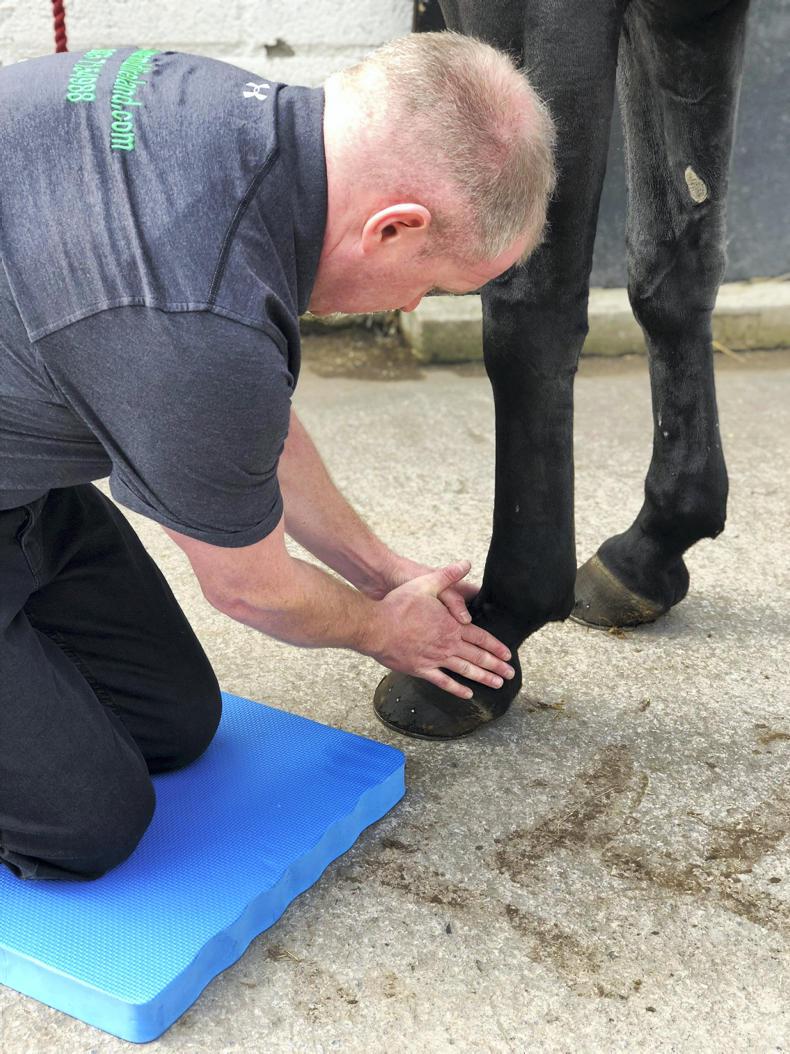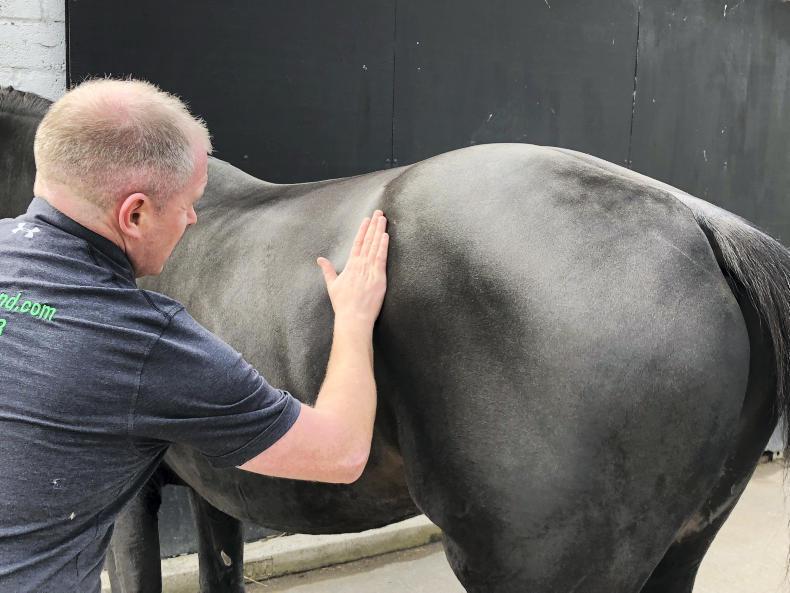WHAT IS MLD?
MLD stands for Manual Lymphatic Drainage. It is a method of stimulating the lymphatic system through a highly skilled and precise manipulation of the skin, using a range of specialised techniques to stimulate the flow of lymph.
Lymph fluid is formed when the fluid in which all cells in the body lie is collected through the lymphatic capillaries. Lymph fluid circulates throughout the lymphatic system, which is the body’s natural waste disposal system. The lymphatic system helps drain the body of proteins, toxins, waste and any other unwanted materials.
MLD is scientifically proven to be very effective on humans, however, it is actually more effective on horses because they have a much higher number of lymph nodes. Horses have approximately 8,000 lymph nodes, while humans only have approximately 600.
Equine MLD was developed in Germany where it is a very popular treatment and is commonly used in conjunction with traditional veterinary medicine practices.
JUSTIN Crudden is from rural Fermanagh and although he didn’t grow up riding horses he spent a great deal of his childhood on his granny’s farm and loves being around animals. So far, Crudden’s career has been as a radiation therapist.
However, circumstances changed and Crudden now finds himself being drawn down a new career path as an equine MLD therapist. In fact, he is currently the only qualified equine MLD therapists in Ireland.
Crudden has welcomed the change of scenery and routine. Recently he has been working short term contracts as a radiation therapist and has been working as an equine MLD therapist in the evenings. His plan is now to focus more on the equine side of things and make it his career.
His jouney to becoming an equine MLD therapist began in 2009 when Crudden started a three-part course, held in America, to become a qualified human MLD therapist. Crudden described the course as very intensive, especially the final part. He overcame the challenge, gained his qualification and began working as a human MLD therapist alongside working as a radiation therapist in 2011.
Crudden is one of fewer than 50 human MLD therapists in Ireland and, like many in Ireland, he found the recession affected business badly. This was combined with a lack of understanding and awareness about the treatment, so as work became less frequent his thoughts turned to how else he could use the qualification.
Through a simple Google search Crudden discovered that his qualification as a human MLD therapist enabled him to do the equine MLD course..
This thought sat in his mind for a couple of years, he said: “I talked about doing it for a couple of years and never actually got around to it.”
EQUINE QUALIFICATION
Over the course of 2018 Crudden completed his equine MLD qualification in Austria. The course was run over three long weekends in the first half of the year. Crudden said there was approximately 12 people on the course, and he was the only Irish person – else was from Switzerland, Austria and France.
Over the duration of the course Crudden treated horses in Austria, where they were studying, and he explained how much the horses enjoyed the treatment:
“Working over on the horses in Austria, they were used to us working on them and treating them – they would be falling asleep. They were just so used to it and so relaxed.”
There are also equine MLD courses available in Germany.
MLD works by clearing the lymphatic system, so when it comes to treating horses Crudden always has a routine which he follows. This allows him to clear the lymphatic pathways before he begins work on the injured area.
Lymph fluid drains back to the heart, so when Crudden is treating a horse he begin by working under the shoulder. He explained how once this area becomes opened up and stimulated he can begin to work back and focus draining the injured area.
HOW IT CAN HELP HORSES
There are a number of benefits to treating horses using Equine MLD. The treatment can help improve general wellbeing and promote overall healthiness. Crudden explained how in humans MLD is used to help heal fractures, reduce swelling and improve fertility to name but a few.
For horses, he finds the treatment to be very effective in dealing with conditions such as laminitis. Although MLD does not offer a cure for laminitis, it works on the condition in two ways. Firstly, MLD is a very effective form of pain relief. Crudden explained how this works: “It’s a great pain reliever because it effects the parasympathetic nervous system and relieves pain nearly straight away and relaxes the horse.”
The second way Equine MLD helps combat laminitis is by improving the lymphatic drainage in the hoof and it gets rid of the debris and relieves pressure in the hoof.
 Crudden sees a gap in the market for equine MLD to be used to aid recovery in horses after training, racing or competition. He explained how a number of human athletes are now using the treatment to help aid their own recovery process.
Crudden sees a gap in the market for equine MLD to be used to aid recovery in horses after training, racing or competition. He explained how a number of human athletes are now using the treatment to help aid their own recovery process.
He explained how this could be very useful with horses: “It’s great for clearing out lactic acid and serum enzymes after exertion. I haven’t actually treated anyone consistently for recovery yet but on the continent it’s used widely for it.”
The treatment also promotes healing and by having MLD treatment the horses’ lymphatic system is stimulated which boosts immunity and detoxifies.
VETERINARY CONSENT
Crudden will not treat horses without consent from a veterinary surgeon, this is because horses with certain underlying conditions are deemed unsuitable for treatment. Crudden explained more: “There are certain underlying conditions that mean a horse can’t be given an MLD treatment – a horse that has an untreated cancer, any infection or thrombosis or if they have any cardiac issues because when you’re draining all the fluid back to the heart you’re putting unnecessary pressure on the heart.”
To help make clients aware of the risks involved if horses do have any of these conditions Crudden has a consent form on his website and he lists of the conditions which make it unsafe to give a horse an equine MLD treatment.
When asked if older horses could face more problems or complications while being given an equine MLD treatment Crudden said that age usually doesn’t come into and the underlying conditions which make it unsafe to give an equine MLD treatment are not usually age related.
There is a science behind MLD, it is a light but powerful treatment. Developed in Germany it is slowly gaining a foothold in veterinary medicine and becoming a popular treatment modalitty for performance horses on the continent. Equine MLD does not contravene anti-doping regulations, an advantage which should not be underestimated as it permitsthe treatment of sport and racehorses at any time.

Justin Crudden giving an equine manual lymph drainage treatment
CUMULATIVE EFFECT
The frequency and number of treatments required very much depends on each individual case and the issue being addressed according to Crudden. MLD has a cumulative effect which means one treatment on its own has very little, if any, effect but if multiple treatments given within a narrow timeframe make the treatment is very effective.
When asked about the frequency of treatments Crudden explained this using examples of different cases, such an laminitis: “Seven treatments over seven days or else you could do every other day for a fortnight. That would be for laminitis.
“Then for different conditions it just depends on each individual case.
“It can be useed for other injuries as well, including any traumatic injury such as cuts, lacerations or bruising. It is also very good for tendon, muscle and ligament injuries as well as poorly healing fractures. It promotes healing essentially,” he added.
Crudden estimated that for the majority of smaller injuries between three and five treatments would be needed.
When the treatment is given correctly the results are usually obviously almost immediately after the treatment.
For more information on Equine MLD Ireland you can visit the website equinemldireland.com or email Justin Crudden at info@equinemldireland.com.